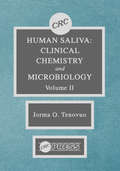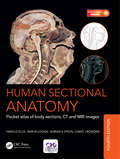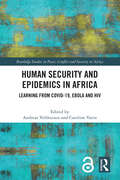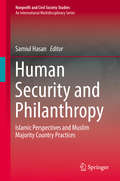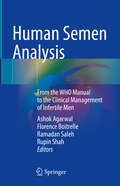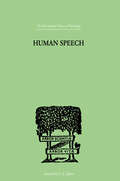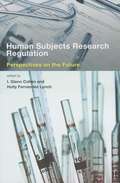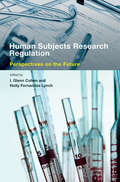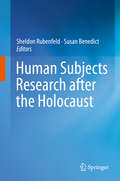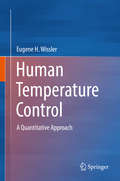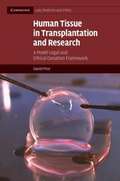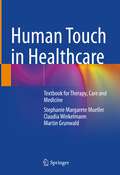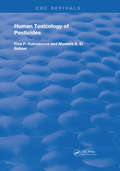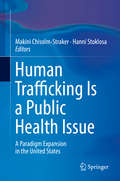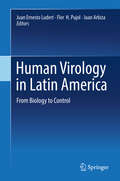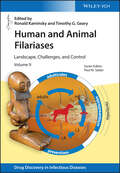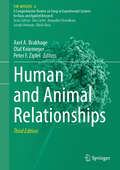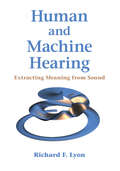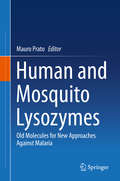- Table View
- List View
Human Saliva, Volume II
by Jorma O. TenovuoThis book covers the current knowledge of salivary compounds, their normal values, age dependency, diseases or hormonal status and assay problems, and is helpful for scientists and clinicians with the relevant information needed in planning, performing, and interpreting saliva analyses.
Human Sectional Anatomy: Pocket atlas of body sections, CT and MRI images, Fourth edition
by Harold Ellis Adrian Kendal Dixon David J. Bowden Bari M. LoganFirst published in 1991, Human Sectional Anatomy set new standards for the quality of cadaver sections and accompanying radiological images. Now in its fourth edition, this unsurpassed quality remains and is further enhanced by the addition of new material. The superb full-colour cadaver sections are compared with CT and MRI images, with accompanying, labelled, line diagrams. Many of the radiological images have been replaced with new examples for this latest edition, captured using the most up-to date imaging technologies to ensure excellent visualization of the anatomy. The photographic material is enhanced by useful notes with details of important anatomical and radiological features. Beautifully presented in a convenient and portable format, the fourth edition of this popular pocket atlas continues to be an essential textbook for medical and allied health students and those taking postgraduate qualifications in radiology, surgery and medicine, and an invaluable ready-reference for all practising anatomists, radiologists, radiographers, surgeons and medics.
Human Security and Epidemics in Africa: Learning from COVID-19, Ebola and HIV (Routledge Studies in Peace, Conflict and Security in Africa)
by Caroline Varin Velthuizen, Edited by AndreasThis book examines the impact of epidemics in Africa, exploring some of the adaptation and crisis management strategies adopted to tackle COVID-19, Ebola, and HIV-AIDS. The authors reflect on lessons learned from solving complex problems and difficult decisions made by leaders on pandemic management to shape the security environment and, thus, the well-being of people living in Africa for years to come.Drawing on cases from across the continent, the book demonstrates that, significantly, during the COVID-19 pandemic, African countries and communities frequently displayed regional solidarity, creativity in decision-making, decisiveness in dealing with corruption and opportunism, and resilience and discipline in implementation. Adopting a human security framework, the authors share their lived experiences and explore the impact of epidemics on public policy decision-making, foreign policy implementation, global relations, collaboration in the community dimension, and, ultimately, the future of socio-economic development in Africa.This book will be a welcome addition for practitioners and researchers across the fields of security studies, health management, and African studies, making an essential contribution to the security discourse in a post-COVID world.
Human Security and Philanthropy
by Samiul HasanMuslims for hundreds of years have been involved in philanthropic activities targeting poor and needy people through varied types of 'third sector' organizations (TSOs). Nonetheless, many people in Muslim majority countries (MMCs), not having freedom from hunger, face human security crises. Not much is known about the TSOs or their human security provisions in MMCs. To fill this knowledge gap, this Volume documents and analyses philanthropy and all types of third sector organizations including the awqaf (Muslim endowments) vis-à-vis human security in MMCs. The study is comprehensive in treating the subject matter (analyzing the legal environment, characteristics, extent and functioning of all forms of the third sector and their human security performances) and in geographic coverage (incorporating all forty-seven Muslim majority countries in Africa and Asia). It is also innovative expounding TSO density analysis, state support score (SSS) and a third-sector capability measure (TCM) to study their interrelationships. It is an essential unique reference book for students and scholars of the third sector and human security, international organizations, development agencies, donor governments, security experts and in particular anybody with interests in Islam and MMCs.
Human Security in China: A Post-Pandemic State
by Chi ZhangThis book explores the emergent concept of 'human security' within the political context of COVID-19 Chinese politics. For decades, Western nations have used 'human rights' as a rubric with which to scold Chinese leaders, betraying a fundamental unwillingness to accept diversity of governance systems. As COVID-19 has demonstrated, different governance systems yield different outcomes—the freedom of circulation, speech and movement in Western democracies yielding one, and use of surveillance, lockdowns, and private–public collaboration in China and Asian societies such as Korea and Singapore yielding another. Chinese political scientists have become fixated on the notion of 'human security,' a utilitarian concept which insists on the importance of protecting and extending human life via health care, technology, and a wide range of other systems—sometimes, in ways which contradict Western notions of human rights, even as they demonstrably achieve superior outcomes for the humans involved. Being the first English language book to explore these issues, this book aims to generate a sustained theoretical relevance in the aftermath of the crisis which is likely to have lasting effects on how people live and will be of note for political scientists, China scholars, and economists.
Human Semen Analysis: From the WHO Manual to the Clinical Management of Infertile Men
by Ashok Agarwal Florence Boitrelle Ramadan Saleh Rupin ShahInfertility is an important public health problem affecting around 15% of couples worldwide. A male factor contributes to about 50% of all cases of infertility. Male infertility could be related to a variety of congenital or acquired causes that lead to abnormal reproductive potential and poor sperm quality and function. To this date, semen analysis remains the cornerstone of male infertility evaluation. Clinicians widely reference the World Health Organization (WHO) Laboratory Manual for the Examination and Processing of Human Semen, which provides a detailed description of a variety of semen tests. However, the manual does not provide a sufficient clinical context for the various tests that are described.This book is intended to bridge the gap between the laboratory manual and the clinician by explaining in detail the test indication, its clinical utility, interpretation of results, and presenting a decision algorithm based on the test results. Thebook has 19 chapters grouped under seven sections that follow the chapters of the sixth edition of the WHO manual. Each chapter is written and reviewed by a team of senior clinicians, thus bringing a perspective that is truly clinically relevant. This book will be of great value to all clinicians involved in the management of male infertility and will also be of interest to laboratory scientists involved in semen testing by providing them with clinical perspectives of the test they perform. Human Semen Analysis: From the WHO Manual to the Clinical Management of Infertile Men is a useful guide for utilizing the WHO manual, interpreting test results, and deciding what subsequent clinical actions to take.
Human Services Integration
by Michael J AustinAddressing the multiple meanings of service integration, Human Services Integration analyzes how motivations and expectations for social service integration differ significantly among different players in the service system. In a period of major budget cutbacks and welfare reform, however, it is important that service providers collaborate to reduce or eliminate boundaries between categorically defined and provided services. This book tells you about the efforts being made to provide existing services more efficiently while avoiding duplication and waste. As you will quickly see, developing consensus for service integration efforts at the administrative, community, and staff levels will result in the ability to set achievable goals and objectives and secure cooperation at all levels.Human Services Integration covers practice principles for managing organizational and community change and offers strategies for organizing human service agencies and overcoming fragmented service integration in communities with complex problems and needs. To also help you identify specific service intergration activities that are relevant in the context of unique communities, it discusses: specifications for conducting a self-assessment of progress at the local level toward social service integration goals Georgia&’s Family Connection, a statewide human services initiative interweaving formal and informal systems of care in a community-centered approach to service integration a children’s initiative collaborative social science theory pertinent to service integration gathering support from elected officials such as boards of supervisors, city leaders, and local elected boardsHuman Services Integration will help you understand why service integration cannot be defined by a particular service model or outcome. Its insight will also help you understand why involving service users and community members in the design and delivery of services is fundamental to developing an integrated service system that is culturally competent, empowering, and responsive to its neighborhood and community context.
Human Speech: Some ObserVATIONS, EXPERIMENTS, AND CONCLUSIONS AS TO THE NATURE,
by Paget, RichardFirst published in 1999. Routledge is an imprint of Taylor & Francis, an informa company.
Human Subjects Research Regulation
by Holly Fernandez Lynch I. Glenn CohenThe current framework for the regulation of human subjects research emerged largely in reaction to the horrors of Nazi human experimentation, revealed at the Nuremburg trials, and the Tuskegee syphilis study, conducted by U.S. government researchers from 1932 to 1972. This framework, combining elements of paternalism with efforts to preserve individual autonomy, has remained fundamentally unchanged for decades. Yet, as this book documents, it has significant flaws -- including its potential to burden important research, overprotect some subjects and inadequately protect others, generate inconsistent results, and lag behind developments in how research is conducted. Invigorated by the U.S. government's first steps toward change in over twenty years, Human Subjects Research Regulation brings together the leading thinkers in this field from ethics, law, medicine, and public policy to discuss how to make the system better. The result is a collection of novel ideas -- some incremental, some radical -- for the future of research oversight and human subject protection.After reviewing the history of U.S. research regulations, the contributors consider such topics as risk-based regulation; research involving vulnerable populations (including military personnel, children, and prisoners); the relationships among subjects, investigators, sponsors, and institutional review boards; privacy, especially regarding biospecimens and tissue banking; and the possibility of fundamental paradigm shifts.ContributorsAdam Braddock, Alexander Morgan Capron, Ellen Wright Clayton, I. Glenn Cohen, Susan Cox, Amy L. Davis, Hilary Eckert, Barbara J. Evans, Nir Eyal, Heidi Li Feldman, Benjamin Fombonne, Elisa A. Hurley, Ana S. Iltis, Gail H. Javitt, Greg Koski, Nicole Lockhart, Holly Fernandez Lynch, Michael McDonald, Michelle N. Meyer, Osagie K. Obasogie, Efthimios Parasidis, Govind Persad, Rosamond Rhodes, Suzanne M. Rivera, Zachary M. Schrag, Seema K. Shah, Jeffrey Skopek, Laura Stark, Patrick Taylor, Anne Townsend, Carol Weil, Brett A. Williams, Leslie E. Wolf
Human Subjects Research Regulation: Perspectives on the Future (Basic Bioethics)
by Holly Fernandez Lynch I. Glenn CohenExperts from different disciplines offer novel ideas for improving research oversight and protection of human subjects.The current framework for the regulation of human subjects research emerged largely in reaction to the horrors of Nazi human experimentation, revealed at the Nuremburg trials, and the Tuskegee syphilis study, conducted by U.S. government researchers from 1932 to 1972. This framework, combining elements of paternalism with efforts to preserve individual autonomy, has remained fundamentally unchanged for decades. Yet, as this book documents, it has significant flaws—including its potential to burden important research, overprotect some subjects and inadequately protect others, generate inconsistent results, and lag behind developments in how research is conducted. Invigorated by the U.S. government's first steps toward change in over twenty years, Human Subjects Research Regulation brings together the leading thinkers in this field from ethics, law, medicine, and public policy to discuss how to make the system better. The result is a collection of novel ideas—some incremental, some radical—for the future of research oversight and human subject protection.After reviewing the history of U.S. research regulations, the contributors consider such topics as risk-based regulation; research involving vulnerable populations (including military personnel, children, and prisoners); the relationships among subjects, investigators, sponsors, and institutional review boards; privacy, especially regarding biospecimens and tissue banking; and the possibility of fundamental paradigm shifts.ContributorsAdam Braddock, Alexander Morgan Capron, Ellen Wright Clayton, I. Glenn Cohen, Susan Cox, Amy L. Davis, Hilary Eckert, Barbara J. Evans, Nir Eyal, Heidi Li Feldman, Benjamin Fombonne, Elisa A. Hurley, Ana S. Iltis, Gail H. Javitt, Greg Koski, Nicole Lockhart, Holly Fernandez Lynch, Michael McDonald, Michelle N. Meyer, Osagie K. Obasogie, Efthimios Parasidis, Govind Persad, Rosamond Rhodes, Suzanne M. Rivera, Zachary M. Schrag, Seema K. Shah, Jeffrey Skopek, Laura Stark, Patrick Taylor, Anne Townsend, Carol Weil, Brett A. Williams, Leslie E. Wolf
Human Subjects Research after the Holocaust
by Sheldon Rubenfeld Susan Benedict"An engaging, compelling and disturbing confrontation with evil . . . a book that will be transformative in its call for individual and collective moral responsibility. " - Michael A. Grodin, M. D. , Professor and Director, Project on Medicine and the Holocaust, Elie Wiesel Center for Judaic Studies, Boston University Human Subjects Research after the Holocaust challenges you to confront the misguided medical ethics of the Third Reich personally, and to apply the lessons learned to contemporary human subjects research. While it is comforting to believe that Nazi physicians, nurses, and bioscientists were either incompetent, mad, or few in number, they were, in fact, the best in the world at the time, and the vast majority participated in the government program of "applied biology. " They were not coerced to behave as they did--they enthusiastically exploited widely accepted eugenic theories to design horrendous medical experiments, gas chambers and euthanasia programs, which ultimately led to mass murder in the concentration camps. Americans provided financial support for their research, modeled their medical education and research after the Germans, and continued to perform unethical human subjects research even after the Nuremberg Doctors' Trial. The German Medical Association apologized in 2012 for the behavior of its physicians during the Third Reich. By examining the medical crimes of human subjects researchers during the Third Reich, you will naturally examine your own behavior and that of your colleagues, and perhaps ask yourself "If the best physicians and bioscientists of the early 20th century could do evil while believing they were doing good, can I be certain that I will never do the same?"
Human Temperature Control: A Quantitative Approach
by Eugene H. WisslerThe principal objective of this book is to provide information needed to define human thermal behavior quantitatively. Human thermal physiology is defined using mathematical methods routinely employed by physicists and engineers, but seldom used by physiologists. Major sections of the book are devoted to blood flow, sweating, shivering, heat transfer within the body, and heat and mass transfer from skin and clothing to the environment. Simple algebraic models based on experimental data from a century of physiological investigation are developed for bodily processes. The book offers an invaluable source of information for physiologists and physical scientists interested in quantitative approaches to the fascinating field of human thermoregulation.
Human Tissue in Transplantation and Research
by David PriceDeficiencies and shortfalls in the supply of human organs for transplantation and human tissue for research generate policy dilemmas across the world and have often given rise to major and deleterious controversies, such as those relating to organ and tissue retention practices following post-mortem examination. They also create an environment in which illegitimate commercial activities flourish. At the same time, patients are denied the therapy they desperately require and researchers are impeded from carrying out vital work into the causes of, and efficacious treatments for, major illnesses and diseases. David Price sets out a clear and integrated legal and policy framework which emanates from the tissue source but protects the interests of donors and relevant professionals through tailored property entitlements, but without presupposing rights to trade in 'original' materials.
Human Tooth Crown and Root Morphology
by Scott Joel D. G. Richard IrishThis guide to scoring crown and root traits in human dentitions substantially builds on a seminal 1991 work by Turner, Nichol, and Scott. It provides detailed descriptions and multiple illustrations of each crown and root trait to help guide researchers to make consistent observations on trait expression, greatly reducing observer error. The book also reflects exciting new developments driven by technology that have significant ramifications for dental anthropology, particularly the recent development of a web-based application that computes the probability that an individual belongs to a particular genogeographic grouping based on combinations of crown and root traits; as such, the utility of these variables is expanded to forensic anthropology. This book is ideal for researchers and graduate students in the fields of dental, physical, and forensic anthropology and will serve as a methodological guide for many years to come.
Human Touch in Healthcare: Textbook for Therapy, Care and Medicine
by Claudia Winkelmann Martin Grunwald Stephanie Margarete MuellerThis textbook presents the essential research findings on human touch and haptic perception in a concise manner for students and health professionals. Focusing on anatomical, neural and physiological as well as psychological, social and clinical aspects, the scope of this book ranges from the fetus in the womb to the older adult in need of care. The chapters can be read individually or consecutively, and cross-chapter content is indicated by chapter references. Key learning points are highlighted at the end of each section, and figures, illustrations, and references facilitate the learning process. The quality of the presented study results has been critically analyzed and only randomized controlled studies are reported, which gives the reader a critical representation of the current state of knowledge. The textbook also provides valuable suggestions for future research by noting blind spots in existing research, and by pointing to methodological challenges in the implementation of high quality studies. Hence, this textbook is not only a representation of current knowledge, but also an epistemological analysis of the research process. There has been a surge of research about the sense of touch in the past ten years, which is incorporated in this book. This textbook will be an invaluable tool for physiotherapists, occupational therapists, nurses and other health professionals in everyday professional life.
Human Toxicology of Pesticides (Routledge Revivals)
by Fina P. Kaloyanova M. A. El BatawiFirst Published in 1991, this book conducts a systematic analysis of existing information regarding the toxicological effects of pesticides on humans. The book identifies the negative health effects related to exposure to pesticides and the biological changes required to undertake biological monitoring. The book also discusses the importance and magnitude of the problem for different kinds of pesticide applications in different parts of the world, explains the toxicodynamics and clinical picture of acute and chronic intoxications resulting from exposure to different groups of pesticides and selected individual substances, and evaluates existing methods and limitations for assessing human exposure to pesticides. Pesticide manufacturers, occupational health professionals, epidemiologists, environmentalists, government agencies and others concerned with the effects of pesticides on human populations should consider this book essential reading.
Human Traces: A Novel (Vintage International Ser.)
by Sebastian FaulksSixteen-year-old Jacques Rebière is living a humble life in rural France, studying butterflies and frogs by candlelight in his bedroom. Across the Channel, in England, the playful Thomas Midwinter, also sixteen, is enjoying a life of ease-and is resigned to follow his father's wishes and pursue a career in medicine. A fateful seaside meeting four years later sets the two young men on a profound course of friendship and discovery; they will become pioneers in the burgeoning field of psychiatry. But when a female patient at the doctors' Austrian sanatorium becomes dangerously ill, the two men's conflicting diagnosis threatens to divide them--and to undermine all their professional achievements. From the bestselling author of Birdsong comes this masterful novel that ventures to answer challenging questions of consciousness and science, and what it means to be human.From the Trade Paperback edition.
Human Trafficking Is a Public Health Issue: A Paradigm Expansion in the United States
by Makini Chisolm-Straker Hanni StoklosaThis clear-sighted reference examines the public health dimensions of labor and sex trafficking in the United States, the scope of the crisis, and possibilities for solutions. Its ecological lifespan approach globally traces risk and protective factors associated with this exploitation, laying a roadmap towards its prevention. Diverse experts, including survivors, describe support and care interventions across domains and disciplines, from the law enforcement and judicial sectors to community health systems and NGOs, with a robust model for collaboration. By focusing on the humanity of trafficked persons, a public health paradigm broadens our understanding of and ability to address trafficking while adding critical direction and resources to the criminal justice and human rights structures currently in place. Among the topics covered:Children at Risk: Foster Care and Human TraffickingLGBTQ Youth and Vulnerability to Sex TraffickingPhysical Health of Human Trafficking Survivors: Unmet EssentialsResearch Informing Advocacy: An Anti-Human Trafficking ToolCaring for Survivors Using a Trauma-Informed Care FrameworkThe Media and Human Trafficking: Discussion and Critique of the Dominant NarrativeHuman Trafficking Is a Public Health Issue is a sobering read; a powerful call to action for public health professionals, including social workers and health care practitioners providing direct services, as well as the larger anti-trafficking community of advocates, prosecutors, taskforce members, law enforcement agents, officers, funders, and administrators. “An extraordinary collection of knowledge by survivors, academics, clinicians, and advocates who are experts on human trafficking. Human Trafficking is a Public Health Issue is a comprehensive offering in educating readers on human trafficking through a multi-pronged public health lens.”Margeaux Gray: Survivor, Advocate, Artist, Public Speaker
Human Trafficking: Perspectives from Nursing, Criminal Justice, and the Social Sciences
by Donna Sabella Mary De ChesnayThis book presents various forms of human trafficking, a growing trend in the exploitation of large numbers of people with concurrent public health, socio-cultural, and economic costs to countries burdened with the consequences of the COVID-19 pandemic. Edited by psychiatric-mental health nurses and an applied anthropologist, this volume covers all forms of human trafficking: sex trafficking, forced labor, forced marriage, baby trafficking, organ trafficking, child marriage, and child soldiers with a global public health and policy focus. As such, it fills a gap in human trafficking knowledge and is built on courses springing up around the United States in multiple disciplines. Medical, mental health, and social work interventions are included as well as information about programs with documented outcomes. Each chapter includes state of the art of knowledge with case studies illustrating specific focal ideas, discussion, questions and exercises in order to help readers retain and reinforce chapter material. This textbook will be useful in the disciplines of nursing, medicine, public health, social work, and policy making, as well as in disciplines in which human trafficking is a current interest, such as law, criminal justice, and education.
Human Virology in Latin America
by Juan Ernesto Ludert Flor H. Pujol Juan ArbizaThis book is a compilation of some of the most remarkable contributions made by scientists currently working in Latin America to the understanding of virus biology, the pathogenesis of virus-related diseases, virus epidemiology, vaccine trials and antivirals development. In addition to recognizing the many fine virologists working in Latin America, Human Virology in Latin America also discusses both the state-of-the-art research and the current challenges that are being faced in the region, in hopes of inspiring young scientists worldwide to become eminent virologists.
Human Viruses: The New Insights
by Shamim I. AhmadThis book discusses current evidence on human viruses and provides an extensive coverage of newly emerged viruses and current strategies for treatment. Offering a new perspective in view of the re-emergence of Ebola in African countries and Dengue in India and Pakistan, the contents include chapters on emergence, pathogenicity, epidemiology and vaccine uptake. Human Viruses: Diseases, Treatments and Vaccines: The New Insights discusses a range of viruses from the most common such as Influenza and Hepatitis to Zika, Poliomyelitis and Chikungunya among many others. It is authored by a team of experts on viral disease and will be of immense use to virologists, public health experts and clinicians.
Human and Animal Filariases: Landscape, Challenges, and Control (Drug Discovery in Infectious Diseases)
by Paul M. SelzerHuman and Animal Filariases The rational approach to controlling human and animal diseases caused by nematodes Filariae are a family of parasitic worms which infect animals and humans, causing severe diseases such as elephantiasis (lymphatic filariasis) and river blindness (onchocerciasis) in humans, as well as heartworm disease (dirofilariasis) in dogs and cats. While the human diseases are rarely fatal, the blindness and disfiguration resulting from these infections constitute a severe burden for the affected individuals and to the healthcare systems in many tropical countries. In 2017, the World Health Organization classified several filariases as neglected tropical diseases and announced a new program seeking to eradicate these infections, which has in turn sparked a new push to develop antifilarial drugs. Considering the current and future import of this topic, Human and Animal Filariases takes a comprehensive look at infections by filarial parasites in humans and in animals. It begins by reviewing the current state of diagnosis and chemotherapy, before addressing the increasing resistance to available antifilarial drugs. This is followed by strategies and approaches for the discovery of novel drugs and finally by looking at alternative and supplementary approaches to combat the parasites, including vector control and vaccination. Human and Animal Filariases readers will find: A comprehensive approach that integrates current chemotherapy with recent advances in antifilarial drug discovery Practical information on assay development, target validation, and required drug product profiles Insights from global experts from leading academic institutions as well as from pharma and healthcare companies Human and Animal Filariases is a unique reference for parasitologists, veterinarians, as well as professionals in the pharmaceutical industry and in public health agencies.
Human and Animal Relationships (The Mycota #6)
by Axel A. Brakhage Peter F. Zipfel Olaf KniemeyerEstimates based on sequencing data suggest that there are around 5.1 million species of fungi. Yet only a small number of fungi are harmful to animals, including humans. In addition to host-pathogen interactions, there are also mutualistic interactions between fungi and animals. Diseases caused by pathogenic fungi range from allergic reactions and superficial infections to invasive mycoses, and have a significant impact on human and animal life. Fungi are also cultivated by animals as a food source in highly developed relationships or are even involved in gut mutualism. This 3rd edition of Volume 6 of The Mycota highlights exemplary interactions between fungal pathogens and their host(s). The book is organized in three parts: Part 1 summarizes our current understanding of important pathogenic fungi such as Candida species, Malassezia yeasts, Aspergillus fumigatus and fungi of the order Mucorales. Part 2 addresses the characterization of the host response towards pathogenic fungi. It focuses on RNA as a mediator of host-pathogen interactions, the human gut mycobiome, the role of the innate immune system in fighting infections, pattern recognition receptors involved in fungal infections, and a summary of established infection models for studying host-fungal-pathogen interactions. Part 3 provides insights into the impact transcriptomics and proteomics technologies have on the research of human-pathogenic fungi. The up-to-date reviews by experts in the field provide the reader with a comprehensive overview of the various research topics in the field of human and animal relationships with fungi and will hopefully help researchers to find inspiration for their own research.
Human and Machine Hearing: Extracting Meaning From Sound
by Richard F. LyonHuman and Machine Hearing is the first book to comprehensively describe how human hearing works and how to build machines to analyze sounds in the same way that people do. Drawing on over thirty-five years of experience in analyzing hearing and building systems, Richard F. Lyon explains how we can now build machines with close-to-human abilities in speech, music, and other sound-understanding domains. He explains human hearing in terms of engineering concepts, and describes how to incorporate those concepts into machines for a wide range of modern applications. The details of this approach are presented at an accessible level, to bring a diverse range of readers, from neuroscience to engineering, to a common technical understanding. The description of hearing as signal-processing algorithms is supported by corresponding open-source code, for which the book serves as motivating documentation.
Human and Mosquito Lysozymes
by Mauro PratoMalaria remains an alarming emergency in developing countries. It is thus urgent to identify any parasite or host molecules that can serve as new affordable markers for early diagnosis of disease complications or as new targets for vector control. In this context, human and mosquito lysozymes are good candidate molecules, as their involvement in malaria has been recently reported by several independent groups. This book reviews the grounded knowledge on malaria etiology and physiopathology, as well as the current approaches for diagnosis, therapy, and vector control. In addition, the emerging evidence on the involvement of human and mosquito lysozymes in malaria from available experimental models and clinical studies is thoroughly discussed, as is the potential use of other antimicrobial peptides against malaria. Intriguingly, the contributors propose that old well-known molecules such as lysozymes might be used as new targets for cost-effective strategies to fight malaria.
